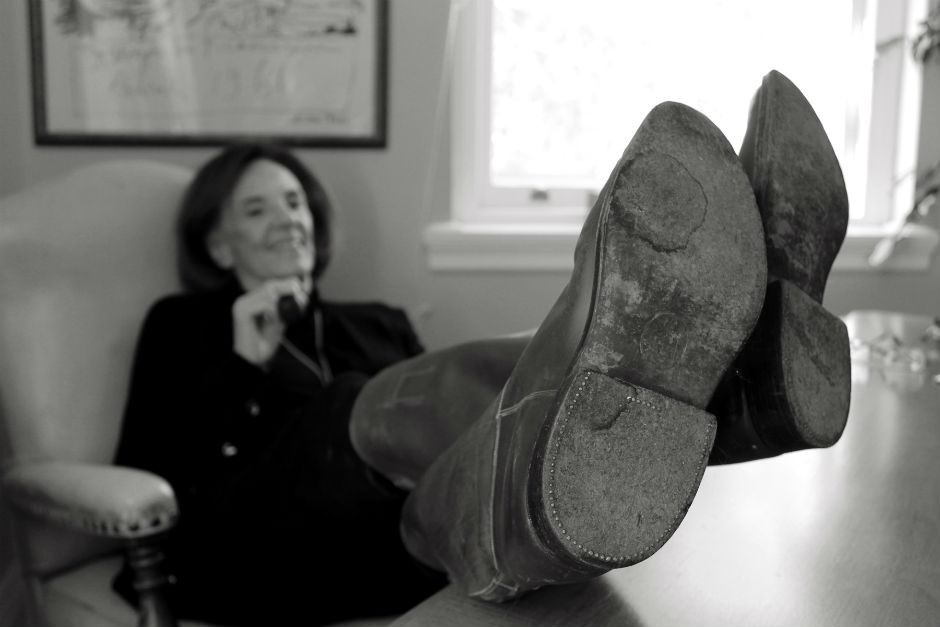Lea Kabiljo is a doctoral candidate in the Art Education program at Concordia, having obtained her Bachelor and Master's degrees from the same department. Prior to returning to Concordia to pursue her PhD she worked as a high school teacher and was the executive director of LOVE: Leave Out Violence, a leading non-profit organization in violence prevention for youth.

EDITOR'S NOTE: This article first appeared in the Quebec Heritage News in fall 2019.
So, I’ve seen in this process all the mishmash of who I am, but I’ve also recognized that it’s turned me into a person that thinks in a multifaceted way; that will spend time with people who feed that need in me, to think not outside the box but outside any box. In other words, I don’t fit into a box. The only time I’ll fit into a box is when I die. But I don’t fit into a box. I fit into the moment.
Twinkle Rudberg
An internet search for ‘Twinkle Rudberg’ instantly returns thousands of results. The numerous national media articles and interviews, the honours and awards, the recurring references to ‘inspiration’ and ‘change maker’ — all lend the impression that Twinkle Rudberg is somewhat of a celebrity. And with every mention of Twinkle, there inevitably follows the acronym LOVE, for the stories of Twinkle and LOVE are one and the same.
On September 30, 1972, Twinkle and her husband, Daniel, headed out for a night of dancing with friends in downtown Montreal. While trying to get their bearings after a wrong turn, they witnessed a mugging — a boy jumped out of a double-parked minivan, snatched the purse of an elderly woman on the sidewalk, and fled.
Daniel gave the wheel to Twinkle, who, unable to park, drove around the block while Daniel and two friends exited the car. One man tended to the victim, the other looked for a phone to call the police, and Daniel ran after the boy. Minutes later, as Twinkle returned to where she had left her husband, she saw a crowd gathered in the lot towards which Daniel had run.
Forcing her way through the crowd, Twinkle saw a body on the ground and recognized Daniel’s shoes. Though nobody would confirm it in the moment, she knew her husband was dead. Later, she would learn that Daniel caught up with the boy, cornering him in the bushes at the back of the lot. The boy panicked and stabbed Daniel with a knife, killing him.
Twinkle’s world collapsed. In a matter of seconds, the happily married woman on her way to dance the night away became a widow left to cope with her grief.
Many years passed before Twinkle came to terms with Daniel’s death. She knew that the boy who killed Daniel was caught and charged in juvenile court. While she was trying to heal from her loss, Twinkle decided to pore over the court proceedings in an attempt to discover what could compel someone to commit such a heinous act.
As it turns out, what she learned about the boy who killed her husband surprised her. Kurt was only 14 years old at the time of the crime. He was raised in Baltimore by a single mother who worked three jobs in order to support her family. The boy ran away from home, eventually making his way to Montreal, where he joined a gang.
On weekends, the young men would raid the city, stealing money for food and drugs. On the day of his initiation, the day he was to commit his first robbery, Kurt was high on LSD. The more she read about Kurt, the more Twinkle realized that he, much like Daniel and her, was also a victim of the cycle of violence.
If this one boy abandoned by society had so easily fallen through the cracks, she wondered how many others with no guidance would take a turn for the worse.
Inspired to end the cycle of violence in the lives of young people, Twinkle founded LOVE: Leave Out Violence. LOVE is a non-profit organization that offers at-risk youth violence-prevention programs centred on media arts, namely photography and journalism.
The organization Twinkle founded in 1993 began its operations with 15 young people in the photo labs of Dawson College in Montreal. Today, LOVE spans the country, with chapters in Halifax, Montreal, Toronto and Vancouver, working with hundreds of youths each year through its in-school and after-school media arts and leadership programs.
During the six years I worked at LOVE alongside Twinkle, I told her story many times. I told Twinkle’s story to the youth I worked with as an intervention worker and to the CEOs of multimillion-dollar corporations, hoping to secure funding for the future of the organization. With every audience the story had the same effect — Twinkle’s resilience touched and inspired them all.
Her ability to turn a personal tragedy into a success story helped thousands of at-risk youth over the years to find their voice through LOVE. For me, as for everyone else, Twinkle and LOVE were inseparable, two intertwined threads of the same narrative.
After I left LOVE to pursue new challenges, Twinkle and I stayed in contact. Over time, our conversations moved from professional to personal. We formed a sort of intergenerational friendship and I began to glimpse Twinkle’s other story, one composed of complex life experiences that made her into the woman she is today.
Undeniably, Daniel’s tragic death and the events it triggered played a significant role in shaping her, but they weren’t the only influences. Through our encounters, I understood that Twinkle sometimes asked herself if her entire existence was reducible to the public face of one well-known tragedy. As our intimacy grew, so did my interest in revealing Twinkle’s other story, the one I was just coming to know.
I proposed to Twinkle a project that combined oral history with photography. Together we would intend to reveal her life story; the one before and after the tragic event that changed her life so profoundly.
Over a period of a few weeks, Twinkle and I recorded more than seven hours of conversation. She talked about her memories, we looked at old photographs and visited places from her youth. Through this process we were able to uncover, discover and recover various shards of information. As our recorded conversations became increasingly personal, I had the privilege to discover the complex woman that she was.
Twinkle told me the story of her adoption at one day old and how she would never know her biological parents. Her adoptive parents, Romanian Jews, came to Montreal at the beginning of the 20th century, seeking a better life. She revealed how she got the name most knew her by — her father always said she was the twinkle in his eye.
She told me stories about her trips, her first kiss, about her friends and her school, about dancing and arts and music, all with an evident love. Twinkle told me stories, and I listened, like a mesmerized child, imagining all the characters and situations she so vividly conjured.
She showed me a photograph of herself at the age of six or so, playing a piano that still sat — she gestured toward it — in her living room today. Another picture showed her father wearing his riding boots, which perched like weathered talismans on a shelf in her office.
Through these photographs and Twinkle’s stories, the past and the present began to merge and I saw how all these facets of a life contributed, mosaic-like, to the totality of the woman I was coming to know.
Following our interview sessions, and based on meaningful objects and memorable moments from her life, we came up together with ideas for different photographs. I remembered the photograph of Twinkle as a little girl playing the piano and suggested we take some photos inspired by it.
Twinkle retrieved the original from her pile of albums. I photographed her with the picture of her as a young girl in the foreground and the woman in the background, playing the same piano. Not formally posing, but rather candid and at ease, Twinkle seemed to bridge the many years between her and the girl she had been with a kind of emotional continuity.
I asked Twinkle if I could photograph her father’s old riding boots, also a feature of several family pictures. As if channeling the whimsy of the girl at the piano, she strapped them on, sat down and propped her feet on her father’s old desk. I started to take pictures – boots out of focus, Twinkle looking at the picture of her father, holding his old pipe.
As I clicked away, I got closer, cropping out the surrounding objects. Among the dozens of photographs, I knew when I had the one I’d been after. I showed it to Twinkle, and she agreed. We had the perfect shot.
That picture, that was Twinkle.
The photograph, seemingly simple, captures the many aspects of Twinkle I had the privilege of discovering during our meetings. In it, she wears her father’s boots. From her stories it was clear that Twinkle had been not only devoted to her father but admired him as well. After he passed, she took over the family business, forced to metaphorically fill his shoes.
With her feet on the desk, Twinkle embodies confidence and assertiveness, affecting a not-to-be-trifled with air. The soles of the boots, the main focus of the photograph, are worn and stained, symbolic of the long and often difficult journey of Twinkle’s life.
Twinkle herself, however, is out of focus. This blurred depiction of Twinkle represents a dimension of her character I have gotten to know only recently, a woman who, despite her considerable strength, is quite shy, preferring to remain out of the spotlight. She gazes at the camera with a faint smile, the subtlety of which only adds to its intrigue.
Through this photograph she is telling us a story. This is Twinkle’s other story. It is the story of a woman beyond the tragedy that publicly defined her.
About the author
